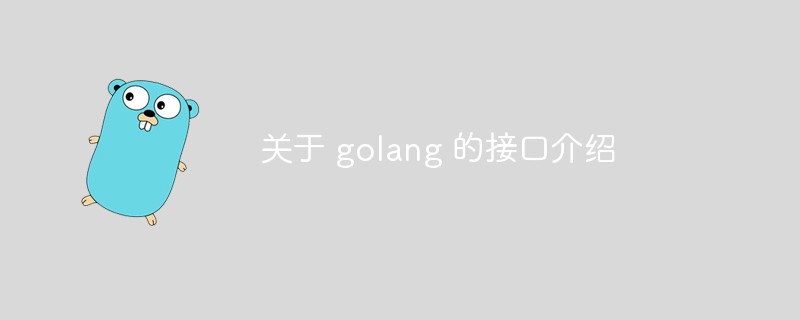
The following column golang tutorial will introduce you to the interface of golang. I hope it will be helpful to friends in need!

#In Go language, interface is a type, an abstract type.
Definition format:
type 接口类型名 interface{
方法名1( 参数列表1 ) 返回值列表1
方法名2( 参数列表2 ) 返回值列表2
…
}When naming Go language interfaces, er is usually added after the word. It is best for the interface name to be Highlight the type meaning of the interface.
As long as an object implements all the methods in the interface, then it implements the interface.
Different types in Go language can implement the same interface. (In the example, both dog and cat implement the Animal interface)
//定义一个Animal接口// Animal 是一个动物接口,实现move()和say()方法type Animal interface {
move()
say()
}//定义dog结构体type dog struct {
name string
}//定义cat结构体type cat struct {
name string
}//dog实现move方法func (d dog) move() {
fmt.Printf("%s会跑\n",d.name)
}//dog实现say方法func (d dog) say() {
fmt.Printf("%s会叫汪汪汪\n",d.name)
}//cat实现move方法func (c *cat) move() {
fmt.Printf("%s会跑\n",c.name)
}//cat实现say方法func (c cat) say() {
fmt.Printf("%s会叫喵喵喵\n",c.name)
}func main() { var a Animal //声明一个Animal类型的a //实例化一个dog结构体
d := dog{name:"旺财"}
fmt.Printf("%T\n", d) //main.dog
d.move() //旺财会跑
d.say() //旺财会叫汪汪汪
a = d // 接口是一种类型,一种抽象的类型。
fmt.Println(a) //{旺财} //实例化一个cat结构体
c := cat{name:"蓝猫"}
c.move() //蓝猫会跑
c.say() //蓝猫会叫喵喵喵
}GO language simulates polymorphism through interfaces.
A type can implement multiple interfaces at the same time, and the interfaces are independent of each other and do not know the implementation of each other.
Different types in Go language can implement the same interface.
New interfaces can be created through nesting between interfaces.
//定义speaker接口type speaker interface {
speak()
}//定义mover接口type mover interface {
move()
}// 接口嵌套type animal interface {
speaker
mover
}//定义cat结构体type cat struct {
name string
}//cat是值类型接收者func (c cat) speak() {
fmt.Println("喵喵喵")
}func (c cat) move() {
fmt.Println("猫会动")
}func main() { var x animal
x = cat{name: "花花"}
x.move() //猫会动
x.speak() //喵喵喵
}Empty interface refers to an interface that does not define any methods. Variables of empty interface type can store variables of any type.
//空接口func main() { var x interface{}
x = 100 //int类型
fmt.Println(x) //100
x = "ares" //string类型
fmt.Println(x) //ares
x = struct { //结构体类型
name string
}{name:"ares"} //结构体赋值
fmt.Println(x) //ares
}Empty interface can be used as a parameter of a function or the value of a map.
//空接口func showType(a interface{}) {
fmt.Printf("type:%T\n", a)
}func main() { //空接口作为函数的参数
showType(100) //type:int
showType("ares") //type:string //定义一个值为空接口的map var stu = make(map[string]interface{},100)
stu["ares"] = 100
stu["ares1"] = "男"
fmt.Println(stu) //map[ares:100 ares1:男] //map,key是字符串,value是任意类型
map1 := make(map[string]interface{})
map1["name"] = "ares"
map1["age"] = 18
map1["id"] = 1
map1["friend"] = struct {
name string
age int
}{"jay", 33}
fmt.Println(map1) //map[age:18 friend:{jay 33} id:1 name:ares]
}is similar to inheritance.
type A interface {
test1()
}type B interface {
test2()
}type C interface {
A
B
test3()
}type Cat struct { //如果要实现接口c,需要将接口a和接口b中的方法一起实现
}func (c Cat) test1() {
fmt.Println("test1...")
}func (c Cat) test2() {
fmt.Println("test2...")
}func (c Cat) test3() {
fmt.Println("test3...")
}func main() { var cat = Cat{}
cat.test1() //test1...
cat.test2() //test2...
cat.test3() //test3... //将cat赋值接口A类型,则只能使用test1方法 var cat1 A = Cat{}
cat1.test1() //test1... //将cat赋值接口B类型,则只能使用test2方法 var cat2 B = Cat{}
cat2.test2() //test2...
}Syntax:
x.(T)
x: Represents a variable of type interface{}
T : Indicates the type that assertion x may be
If true, it indicates that the assertion is successful, and if it is false, it indicates that the assertion fails.
//类型断言func justifyType(x interface{}) { switch v := x.(type) { case string:
fmt.Printf("x is a string,value is %v\n", v) case int:
fmt.Printf("x is a int is %v\n", v) case bool:
fmt.Printf("x is a bool is %v\n", v) case *string:
fmt.Printf("x is a point指针 is %v\n", v) case struct{}:
fmt.Printf("x is a struct is %v\n", v) default:
fmt.Println("unsupport type!")
}}func main() {
justifyType(100) //x is a int is 100
justifyType("ares") //x is a string,value is ares
justifyType(false) //x is a bool is false
x := "ares"
justifyType(&x) //x is a point指针 is 0xc000094010
justifyType(struct {}{}) //x is a struct is {}
justifyType([]int{123}) //unsupport type!
}If the receiver is a pointer type, the value cannot be Pass it in.
//定义animal接口type animal interface {
speak()
move()
}//定义cat结构体type cat struct{
name string
}//定义dog结构体type dog struct{
name string
}//值接收者
func (c cat) speak() {
fmt.Printf("%s会叫喵喵喵\n",c.name)
} func (c cat) move() {
fmt.Printf("%s会动\n",c.name)
} //指针接收者func (d *dog) speak() {
fmt.Printf("%s会叫汪汪汪\n",d.name)
}func (d *dog) move() {
fmt.Printf("%s会动\n",d.name)
}func main() { var c1 animal
lm := cat{name:"蓝猫"}
c1 = lm //因为实现animal接口的是cat值类型,所以可以直接赋值
c1.move() //蓝猫会动
c1.speak() //蓝猫会叫喵喵喵 var c2 animal
jm := &dog{name:"金毛"} //现animal接口的是*dog类型,所以必须要通过&来取值
c2 = jm
c2.move() //金毛会动
c2.speak() //金毛会叫汪汪汪
}The above is the detailed content of Introduction to the interface of golang. For more information, please follow other related articles on the PHP Chinese website!
 How to define variables in golang
How to define variables in golang
 What are the data conversion methods in golang?
What are the data conversion methods in golang?
 What are the commonly used libraries in golang?
What are the commonly used libraries in golang?
 What is the difference between golang and python
What is the difference between golang and python
 Interview assessment tools
Interview assessment tools
 Windows 10 service outage time
Windows 10 service outage time
 Quick shutdown shortcut key
Quick shutdown shortcut key
 How to download nvidia control panel
How to download nvidia control panel




